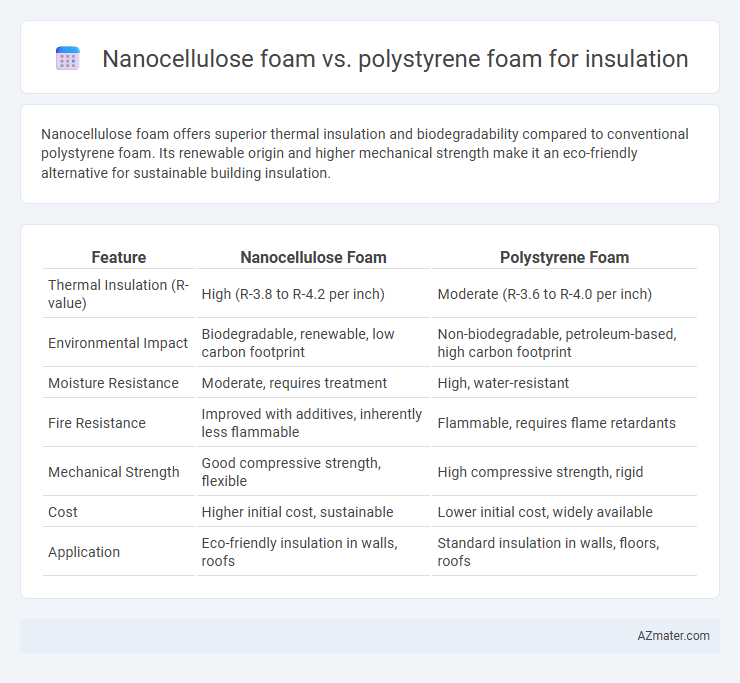Nanocellulose foam offers superior thermal insulation and biodegradability compared to conventional polystyrene foam. Its renewable origin and higher mechanical strength make it an eco-friendly alternative for sustainable building insulation.
Table of Comparison
| Feature | Nanocellulose Foam | Polystyrene Foam |
|---|---|---|
| Thermal Insulation (R-value) | High (R-3.8 to R-4.2 per inch) | Moderate (R-3.6 to R-4.0 per inch) |
| Environmental Impact | Biodegradable, renewable, low carbon footprint | Non-biodegradable, petroleum-based, high carbon footprint |
| Moisture Resistance | Moderate, requires treatment | High, water-resistant |
| Fire Resistance | Improved with additives, inherently less flammable | Flammable, requires flame retardants |
| Mechanical Strength | Good compressive strength, flexible | High compressive strength, rigid |
| Cost | Higher initial cost, sustainable | Lower initial cost, widely available |
| Application | Eco-friendly insulation in walls, roofs | Standard insulation in walls, floors, roofs |
Introduction to Nanocellulose and Polystyrene Foams
Nanocellulose foam, derived from plant-based cellulose fibers, offers a sustainable and biodegradable alternative with high thermal insulation and mechanical strength. Polystyrene foam, a petroleum-based polymer, is widely used for insulation due to its lightweight structure, moisture resistance, and cost-effectiveness. Both materials provide effective thermal barriers, but nanocellulose foam emphasizes eco-friendly advantages while polystyrene foam dominates conventional insulation markets.
Material Composition and Structure Comparison
Nanocellulose foam consists of cellulose nanofibers derived from plant sources, creating a highly porous, lightweight matrix with excellent mechanical strength and thermal insulation properties. Polystyrene foam, composed of expanded polystyrene beads, features a closed-cell structure that provides effective moisture resistance but comparatively lower biodegradability. The nanocellulose foam's nanoscale fibrillar network enables superior thermal performance and breathability, whereas polystyrene foam relies on trapped air pockets within its polymeric matrix for insulation efficiency.
Thermal Insulation Efficiency
Nanocellulose foam offers superior thermal insulation efficiency compared to polystyrene foam due to its high porosity and low thermal conductivity, typically ranging between 0.02 to 0.04 W/m*K. Polystyrene foam, with a thermal conductivity around 0.03 to 0.04 W/m*K, provides effective insulation but lacks the biodegradability and sustainable properties of nanocellulose. The enhanced moisture resistance and mechanical strength of nanocellulose foam further improve its insulation performance in diverse environmental conditions.
Mechanical Strength and Durability
Nanocellulose foam exhibits superior mechanical strength compared to polystyrene foam, offering enhanced load-bearing capacity and resistance to deformation under stress. The nanofibrillated structure of nanocellulose contributes to its exceptional durability, maintaining structural integrity over prolonged use and exposure to varying environmental conditions. Unlike polystyrene foam, which tends to become brittle and degrade under UV exposure and moisture, nanocellulose foam retains flexibility and strength, making it a more reliable insulation material for long-term applications.
Environmental Impact and Sustainability
Nanocellulose foam offers a significantly lower environmental impact than polystyrene foam due to its biodegradability and renewable cellulose source derived from plant fibers. Unlike polystyrene foam, which contributes to persistent plastic pollution and is challenging to recycle, nanocellulose foam decomposes naturally and supports circular economy principles. Sustainable production of nanocellulose foam reduces carbon footprint and dependence on fossil fuels, making it an eco-friendly alternative for insulation applications.
Fire Resistance and Safety Aspects
Nanocellulose foam offers superior fire resistance compared to polystyrene foam, as it is less flammable and can be treated with non-toxic fire retardants, enhancing safety in insulation applications. Polystyrene foam, commonly used in insulation, poses higher fire hazards due to its combustible nature and toxic smoke emission when burned. The enhanced safety profile of nanocellulose foam makes it a preferable choice for environmentally conscious construction projects requiring effective fire-resistant insulation.
Moisture Resistance and Breathability
Nanocellulose foam offers superior moisture resistance compared to polystyrene foam due to its inherent hydrophobic treatment and nanofiber network structure, which limits water absorption and prevents mold growth. Polystyrene foam, while lightweight and effective in thermal insulation, tends to trap moisture, reducing breathability and potentially causing condensation-related damage in building envelopes. The breathability of nanocellulose foam enhances indoor air quality by allowing vapor diffusion, making it a more sustainable choice for insulation where moisture control is critical.
Cost Analysis and Market Availability
Nanocellulose foam offers a higher initial material cost compared to polystyrene foam but delivers long-term savings through superior thermal performance and biodegradability. Polystyrene foam remains widely available and cost-effective due to established manufacturing processes and large-scale distribution. Market trends indicate growing demand for sustainable insulation materials, potentially boosting nanocellulose foam production and reducing its price over time.
Applications in Construction and Packaging
Nanocellulose foam offers superior thermal insulation and biodegradability compared to polystyrene foam, making it an eco-friendly alternative for construction applications such as wall insulation and roofing panels. In packaging, nanocellulose foam provides enhanced cushioning and moisture resistance while reducing environmental impact due to its renewable nature. Polystyrene foam remains widely used for its cost-effectiveness and lightweight properties but faces increasing regulatory restrictions due to its non-biodegradable composition.
Future Trends and Research Directions
Nanocellulose foam, derived from renewable biomass, offers superior biodegradability and thermal insulation compared to traditional polystyrene foam, driving increased research into sustainable building materials. Emerging trends focus on enhancing the mechanical strength and moisture resistance of nanocellulose composites through nanotechnology and chemical modifications. Future studies prioritize scalable manufacturing processes and integration with smart technologies to optimize energy efficiency in green construction.

Infographic: Nanocellulose foam vs Polystyrene foam for Insulation
 azmater.com
azmater.com